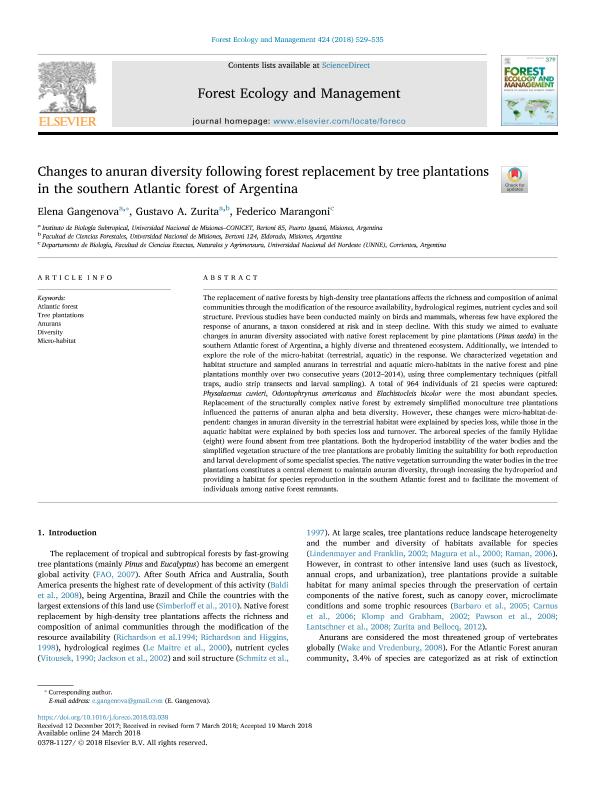Mostrar el registro sencillo del ítem
dc.contributor.author
Gangenova, Elena

dc.contributor.author
Zurita, Gustavo Andres

dc.contributor.author
Marangoni, Federico

dc.date.available
2019-10-02T15:21:03Z
dc.date.issued
2018-09
dc.identifier.citation
Gangenova, Elena; Zurita, Gustavo Andres; Marangoni, Federico; Changes to anuran diversity following forest replacement by tree plantations in the southern Atlantic forest of Argentina; Elsevier Science; Forest Ecology and Management; 424; 9-2018; 529-535
dc.identifier.issn
0378-1127
dc.identifier.uri
http://hdl.handle.net/11336/85023
dc.description.abstract
The replacement of native forests by high-density tree plantations affects the richness and composition of animal communities through the modification of the resource availability, hydrological regimes, nutrient cycles and soil structure. Previous studies have been conducted mainly on birds and mammals, whereas few have explored the response of anurans, a taxon considered at risk and in steep decline. With this study we aimed to evaluate changes in anuran diversity associated with native forest replacement by pine plantations (Pinus taeda) in the southern Atlantic forest of Argentina, a highly diverse and threatened ecosystem. Additionally, we intended to explore the role of the micro-habitat (terrestrial, aquatic) in the response. We characterized vegetation and habitat structure and sampled anurans in terrestrial and aquatic micro-habitats in the native forest and pine plantations monthly over two consecutive years (2012–2014), using three complementary techniques (pitfall traps, audio strip transects and larval sampling). A total of 964 individuals of 21 species were captured: Physalaemus cuvieri, Odontophrynus americanus and Elachistocleis bicolor were the most abundant species. Replacement of the structurally complex native forest by extremely simplified monoculture tree plantations influenced the patterns of anuran alpha and beta diversity. However, these changes were micro-habitat-dependent: changes in anuran diversity in the terrestrial habitat were explained by species loss, while those in the aquatic habitat were explained by both species loss and turnover. The arboreal species of the family Hylidae (eight) were found absent from tree plantations. Both the hydroperiod instability of the water bodies and the simplified vegetation structure of the tree plantations are probably limiting the suitability for both reproduction and larval development of some specialist species. The native vegetation surrounding the water bodies in the tree plantations constitutes a central element to maintain anuran diversity, through increasing the hydroperiod and providing a habitat for species reproduction in the southern Atlantic forest and to facilitate the movement of individuals among native forest remnants.
dc.format
application/pdf
dc.language.iso
eng
dc.publisher
Elsevier Science

dc.rights
info:eu-repo/semantics/openAccess
dc.rights.uri
https://creativecommons.org/licenses/by/2.5/ar/
dc.subject
ANURANS
dc.subject
ATLANTIC FOREST
dc.subject
DIVERSITY
dc.subject
MICRO-HABITAT
dc.subject
TREE PLANTATIONS
dc.subject.classification
Conservación de la Biodiversidad

dc.subject.classification
Ciencias Biológicas

dc.subject.classification
CIENCIAS NATURALES Y EXACTAS

dc.title
Changes to anuran diversity following forest replacement by tree plantations in the southern Atlantic forest of Argentina
dc.type
info:eu-repo/semantics/article
dc.type
info:ar-repo/semantics/artículo
dc.type
info:eu-repo/semantics/publishedVersion
dc.date.updated
2019-09-27T15:00:49Z
dc.journal.volume
424
dc.journal.pagination
529-535
dc.journal.pais
Países Bajos

dc.journal.ciudad
Amsterdam
dc.description.fil
Fil: Gangenova, Elena. Consejo Nacional de Investigaciones Científicas y Técnicas. Centro Científico Tecnológico Conicet - Nordeste. Instituto de Biología Subtropical. Universidad Nacional de Misiones. Instituto de Biología Subtropical; Argentina
dc.description.fil
Fil: Zurita, Gustavo Andres. Consejo Nacional de Investigaciones Científicas y Técnicas. Centro Científico Tecnológico Conicet - Nordeste. Instituto de Biología Subtropical. Universidad Nacional de Misiones. Instituto de Biología Subtropical; Argentina. Universidad Nacional de Misiones. Facultad de Ciencias Forestales; Argentina
dc.description.fil
Fil: Marangoni, Federico. Consejo Nacional de Investigaciones Científicas y Técnicas. Centro Científico Tecnológico Conicet - Nordeste; Argentina. Universidad Nacional del Nordeste. Facultad de Ciencias Exactas, Naturales y Agrimensura. Departamento de Biología; Argentina
dc.journal.title
Forest Ecology and Management

dc.relation.alternativeid
info:eu-repo/semantics/altIdentifier/doi/http://dx.doi.org/10.1016/j.foreco.2018.03.038
dc.relation.alternativeid
info:eu-repo/semantics/altIdentifier/url/https://www.sciencedirect.com/science/article/pii/S0378112717321126
Archivos asociados
